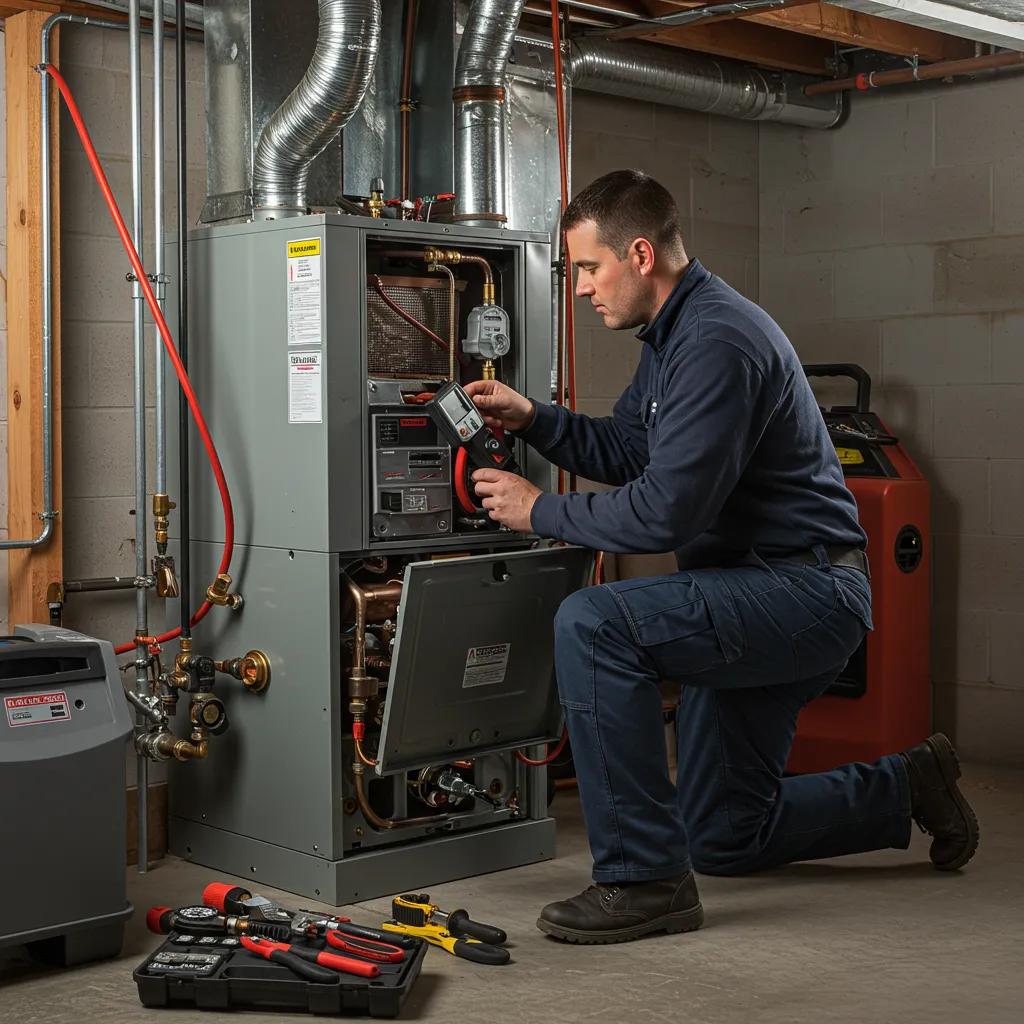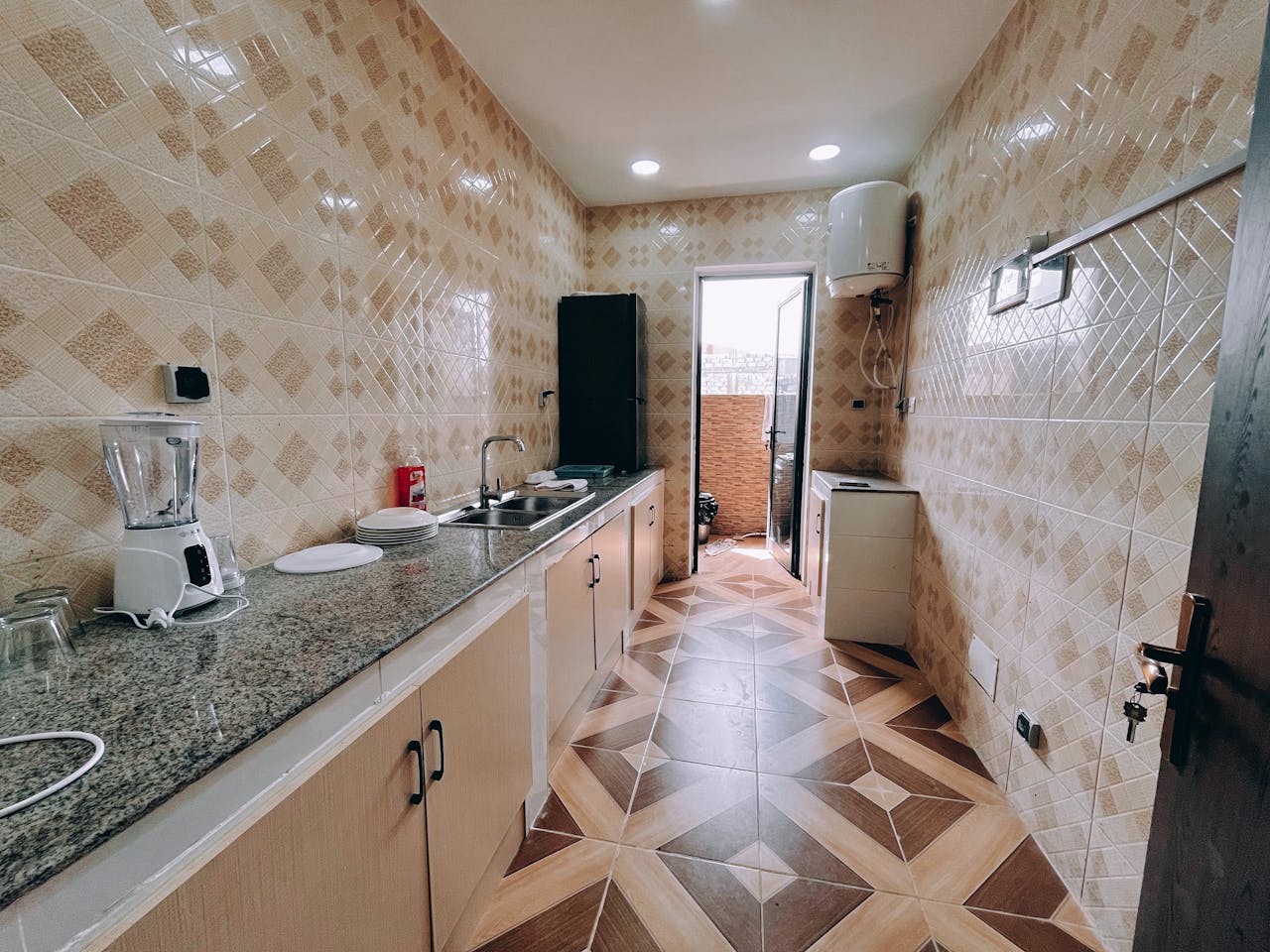Common Furnace Not Heating Issues & How to Fix Them

Troubleshooting Furnace Heating Problems: Common Causes and Solutions for Reliable Home Heating
Many homeowners in colder months face a furnace that won’t heat reliably, and troubleshooting the issue quickly reduces discomfort and prevents costly damage. This guide explains common causes of furnace heating problems, walks through safe DIY checks, and outlines when electrical, ignition, or mechanical faults require a professional technician. You will learn how thermostat settings, power supply issues, airflow restrictions, and ignition failures each produce specific symptoms and what practical steps to take to diagnose them. The article maps clear step-by-step checks for furnaces blowing cold air, prioritized electrical and ignition troubleshooting for furnaces that won’t turn on, and preventative maintenance strategies to reduce future breakdowns. Local homeowners will also find guidance on when to call a repair company in Fenton, MO, and what to expect from professional services and maintenance agreements. Keywords covered include furnace troubleshooting, furnace not heating, furnace blowing cold air, thermostat troubleshooting, and emergency furnace repair to help you resolve heating problems efficiently.
Why Is My Furnace Not Heating? Key Causes and Quick Fixes
A furnace not producing heat usually stems from four broad issues: control problems (thermostat and settings), power interruptions (switches or breakers), airflow restrictions (filters and vents), or ignition and combustion failures (pilot, ignitor, or gas supply). Identifying which category applies begins with prioritized DIY checks that safely separate simple fixes from hazardous conditions. Start by confirming thermostat mode and setpoint, then verify basic power and airflow before approaching ignition components. Understanding these categories lets you decide whether a quick homeowner action will restore heat or if the fault needs professional diagnostics and repair.
Common immediate causes homeowners can check include:
- Thermostat misconfiguration or dead batteries: Incorrect mode or discharged batteries prevent the furnace from calling for heat.
- Tripped circuit breaker or furnace switch off: Power interruptions stop the control board and blower from operating.
- Dirty air filter or closed vents: Restricted airflow can trigger safety limits that prevent burners from firing.
- Pilot out or failed ignitor: No ignition means the furnace won’t generate heat even if everything else appears normal.
How Do Thermostat Issues Affect Furnace Heating?
A thermostat acts as the control signal for a furnace: when it calls for heat, the furnace responds by initiating ignition and the blower sequence. Common thermostat issues include wrong mode (fan set to ON instead of AUTO), incorrect setpoint, depleted batteries, or wiring faults that prevent the signal from reaching the furnace. Start by setting the thermostat to HEAT and raising the setpoint a few degrees, then replace batteries and verify the display and status lights. If the thermostat is programmable or smart, check schedules and temporary hold settings that may override manual commands and create the appearance of no heat.
If basic thermostat steps don’t restore operation, the problem may be wiring or an internal thermostat failure; in that case, documenting observed behavior (no display, no click, or error codes) helps a technician diagnose the control circuit. Proper thermostat placement and compatibility with your furnace also matter because incorrect wiring or an incompatible smart thermostat can cause intermittent heating calls. Addressing thermostat issues often restores heat quickly, and when it does not, the next logical area to inspect is the furnace’s power supply and safety switches.
What Power Supply Problems Can Prevent Furnace Operation?
Power supply problems commonly present as a furnace that is completely unresponsive: no lights on the control board, no blower hum, and no ignition attempts. Typical culprits include the dedicated furnace switch turned off, a tripped circuit breaker at the service panel, a blown fuse, or a disconnected power cord where accessible. Begin with a visual check of the furnace power switch (usually on the cabinet) and then inspect the home electrical panel for tripped breakers; safely reset a tripped breaker only once and monitor for immediate re-trip as a sign of a deeper fault.
Electrical issues carry safety risk, so if resetting the breaker repeatedly doesn’t hold or if you detect burning smells or sparking, shut off power and call a professional electrician or HVAC technician. Proper documentation of breaker behavior and any visual signs of electrical damage will speed diagnosis; next, if power is confirmed but the furnace still won’t fire, ignition components merit inspection.
How Can I Fix a Furnace That’s Blowing Cold Air? Diagnosis and Repair Tips
A furnace that runs but blows cold air usually indicates a failure in heat generation or a severe airflow restriction. The most common homeowner remedies address airflow first—dirty filters, closed vents, or blocked returns—because restoring airflow often resolves inadequate heat distribution quickly. If airflow checks don’t help, the issue may be in the ignition system, heat exchanger, or blower motor, each producing characteristic symptoms that point toward repair or replacement. Prioritizing checks from low-risk DIY actions to professional diagnostics reduces risk and often saves time and expense.
Before moving into mechanical diagnostics, perform these quick checks:
- Inspect and replace the air filter to ensure unrestricted flow.
- Open supply and return vents and verify registers are unobstructed.
- Confirm the thermostat calls for heat and observe whether the burners ignite when the furnace cycles.
- Listen for the blower: if the blower runs but no heat is present, ignition or heat exchanger faults are likely.
After these steps, if burners do not light or the flame is weak, call an HVAC professional to inspect ignition components and heat exchanger integrity since these affect safe combustion and require trained service.
What Role Do Dirty Air Filters and Clogged Vents Play?
Dirty air filters and obstructed vents restrict airflow, forcing the furnace to overwork while failing to deliver heated air throughout the home. Restricted flow can trip high-limit safety switches that shut burners off to prevent overheating, causing the system to run but only circulate cold air. Replace common pleated or fiberglass filters every 1–3 months based on household conditions, and check for closed or blocked supply and return grilles that reduce airflow to specific rooms. If filter replacement and vent clearing do not restore heat, ducts or more complex blockages could be present, and professional duct cleaning or balancing may be necessary.
Maintaining unobstructed airflow not only restores comfort but also reduces strain on blower motors and improves equipment life, making filter checks a high-impact preventative step. If you notice persistent hotspots, strange noises, or recurring filter clogging, retain a qualified technician to inspect the ductwork and blower assembly.
How Do Mechanical Failures Like Blower Motor Issues Cause Cold Air?
The blower motor circulates warmed air through ductwork; when it fails or runs weakly because of a bad motor, capacitor, or worn bearings, heated air can’t reach living spaces even though burners produce heat. Symptoms include a humming sound without fan movement, intermittent operation, or louder-than-normal fan noise indicating worn bearings. A temporary observation step is to power-cycle the furnace to see if the blower resets, but do not attempt internal motor repairs without proper tools and training because starter capacitors and motor mounts present safety risks.
Professional diagnosis will measure current draw, test capacitors, and evaluate whether motor replacement or capacitor service is the correct remedy, with repairs restoring proper airflow and preventing heat exchanger stress. Proper blower performance is essential for safe, efficient heating and must be addressed promptly when suspected.
What Should I Do When My Furnace Won’t Turn On? Electrical and Ignition Troubleshooting
When a furnace refuses to start, treat power and ignition issues as separate prioritized domains: first verify safe power delivery, then check ignition/pilot systems only as permitted by safety guidelines. A structured approach reduces risk and often reveals straightforward fixes like resetting a breaker or replacing thermostat batteries. For gas furnaces, ignition systems (pilot, thermocouple, or electronic ignitor) are common failure points and pose gas-safety concerns that demand professional attention if basic relight procedures do not work.
Follow this prioritized safety checklist:
- Confirm thermostat calls for heat and batteries are fresh.
- Check the furnace power switch and circuit breaker and reset if tripped.
- Inspect the furnace control board lights for diagnostic codes and observe any error indicators.
- Do not attempt gas-valve or internal combustion repairs if you smell gas or see damaged components; evacuate and contact professionals.
After basic electrical checks, if the furnace still won’t turn on or if you detect gas odors or repeated electrical trips, this is the point to contact a trained HVAC technician for safe ignition and gas-system inspection. Experienced technicians can safely test ignitors, thermocouples, control boards, and gas valves, restoring reliable operation while ensuring code-compliant repairs.
How to Check Circuit Breakers, Furnace Switches, and Power Sources
Start electrical troubleshooting by locating the furnace power switch on or near the unit; ensure it is in the ON position, as it is sometimes turned off during home projects. Next, inspect the main electrical panel for a tripped breaker labeled for the furnace and reset it once; if the breaker trips again immediately, cut power and get professional assistance to avoid fire risk. Look at the furnace for a visible fuse or fused disconnect where a blown fuse can be replaced with the correct type and rating, but only if you are comfortable and the unit is powered down first.
If basic resets don’t restore function or you see signs of electrical damage—burn marks, melted insulation, or persistent arcing—stop and call a licensed electrician or HVAC technician for safe diagnosis. Properly documenting what you tried and any visible signs at the unit speeds professional repair and reduces time to restore heat.
What Are Common Pilot Light and Ignitor Problems?
Pilot lights on older furnaces can go out due to drafts, thermocouple failure, or clogged pilot orifices, while modern electronic ignitors fail due to wear, cracked ceramic, or control circuit faults. Symptoms include repeated clicking without ignition, visible flame instability, or the smell of unburned gas—each requiring immediate caution. For pilot-based systems, relighting instructions are sometimes safe if manufacturer procedures are followed and no gas smell is present; for electronic ignitors, replacement typically requires a trained technician because it involves handling fragile components and verifying proper flame sensing.
If you smell gas, experience repeated ignition failures, or are unsure of safe relighting steps, evacuate the area and contact emergency repair services; experienced technicians provide safe ignition repairs and can assess whether related components—like the flame sensor, thermocouple, or control board—need replacement.
What Are the Most Common Furnace Problems and How Can I Prevent Them?
Common furnace failures include clogged filters, thermostat faults, blower motor or capacitor issues, ignition and flame-sensing failures, short cycling caused by airflow or control problems, and heat exchanger concerns that can affect safety. Preventative maintenance addresses most of these through routine inspection, cleaning, lubrication, and calibration that keeps systems operating within design parameters. Regular attention reduces emergency repair calls and improves efficiency, extending equipment life while helping homeowners avoid large replacement costs. Implementing a predictable maintenance cadence and simple homeowner checks prevents many common failures before they interrupt heating.
A preventative checklist homeowners should follow includes:
- Replace or inspect filters monthly to quarterly depending on use.
- Verify thermostat schedules and battery status seasonally.
- Keep registers and returns clear of obstructions and furniture.
- Schedule professional tune-ups annually to inspect ignition, burners, and electrical components.
How Does Regular Maintenance Reduce Furnace Breakdowns?

Regular maintenance reduces furnace breakdowns by catching wear patterns and component drift before they escalate into failures, improving combustion efficiency and preventing heat exchanger stress. A professional tune-up typically includes filter checks, burner cleaning, ignition and flame sensor inspection, blower motor performance testing, and safety control verification, which collectively reduce emergency repair frequency. Documented benefits include fewer unexpected failures and generally improved seasonal efficiency, translating into lower operating costs and fewer urgent service calls during peak cold weather. Scheduling annual service aligns with manufacturer recommendations and is particularly valuable before heavy-use seasons.
When Should I Replace Furnace Components Like Filters and Flame Sensors?
Filters should be replaced on a schedule based on type and household conditions: basic fiberglass monthly, pleated filters every 1–3 months, and higher-efficiency filters per manufacturer guidance when airflow remains adequate. Flame sensors typically last several years but may require cleaning during tune-ups and replacement if flame-detection errors persist; symptoms include frequent shutdowns shortly after ignition. Capacitors and motors show gradual performance decline—start replacement consideration when noise, slow startup, or overheating appears. When in doubt, professional inspection can measure component performance and recommend the most cost-effective option between repair and replacement.
Timely replacement balances upfront cost against energy efficiency and the risk of emergency failure; addressing small parts early often prevents larger, more expensive repairs.
When Should I Call a Professional for Furnace Repair in Fenton, MO? Signs and Emergency Tips
Call a professional immediately if you detect clear emergency signs such as the smell of gas, a triggered carbon monoxide alarm, visible electrical sparking, recurrent breaker trips, or complete loss of heat during extreme cold. These conditions exceed safe DIY intervention and require trained technicians who can perform safe gas shutoff, leak testing, carbon monoxide diagnostics, and code-compliant electrical repairs. For non-emergency but serious symptoms—short cycling, persistent flame instability, or suspected heat exchanger cracks—schedule prompt professional service to avoid escalating hazards and efficiency losses. While waiting for service, take sensible interim steps like ventilating spaces if odor is present and keeping children and pets away from the furnace.
Hiring experienced technicians brings diagnostic tools and authorized-dealer access to proper replacement parts, which shortens time-to-repair and ensures warranty-safe service. Hely Heating and Air Conditioning Co. emphasizes experienced technicians and 24/7 emergency availability for residents across St. Louis and Jefferson Counties, including Fenton, MO; their repair services, maintenance agreements, and the $99 Furnace Clean and Check offer practical ways to restore safe heat and reduce future emergency callouts. To request a service appointment or an estimate, homeowners can contact Hely to schedule professional diagnostics and repairs.
Conclusion
Addressing furnace heating problems effectively ensures a warm and comfortable home during the cold months. By understanding common issues and implementing preventative maintenance, homeowners can avoid costly repairs and enhance the longevity of their heating systems. For those in Fenton, MO, seeking reliable service, consider reaching out to experienced professionals who can provide timely diagnostics and repairs. Explore our services today to ensure your furnace operates efficiently and safely all winter long.






.avif)


